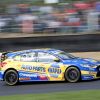Alan Gow commends performance of the NGTC teams
BTCC Series Director Alan Gow says the Next Generation Touring Car has finally started to show what the NGTC concept is capable of at Snetterton, asking to ‘Give it time’, after a notable step-up in pace and reliability last weekend.
Frank Wrathall qualified in seventh place on the grid in the Dynojet Racing Toyota Avensis, just under four-tenths of a second down on pole sitter Jason Plato’s Chevrolet Cruze, with Rob Austin’s Audi A4 not too distant in 14th, less than a second further behind.
Wrathall went on to finish fourth in race one claiming the win in the BTCC independents’ class, and fought hard with Jason Plato in race two for nine laps around the three-mile circuit for the final podium position.
“It is impressive but it’s done nothing more than what we’ve said all year,” said Gow to TouringCarTimes. “Give it time, it’s a developing car…the other fantastic demonstration was (Dan) Welch. The first day the car’s turned a corner, to come out and be only two seconds off the pole time on a two minute lap time is really impressive.”
The reliability of the Welch Motorsport Proton on its first race meeting far exceeded that seen for the other cars built by GPR Motorsport for the other three NGTC teams Dynojet, Rob Austin Racing and Speedworks Motorsport at the beginning of the season. When asked if perhaps it was too early for them to take to the track in March, Gow responded:
“That’s the decision that those teams made. They knew that the design programme was running a bit late and they decided they wanted to come out and race the cars straight away and do their development if you like and testing in front of everyone, and I’ve always taken my hat off to that and thought that’s very brave and a great thing to do.”
“You’re developing a car for one of the toughest touring car championships in the world and you’ve now seen that in half a season the car’s there, when you also remember that car is about 100 kilos heavier than say the pole position car, because they’re a heavier car, to be only that small amount off the pace, that’s bloody impressive.”
The full NGTC cars are also running to a higher boost setting on their turbochargers than the other turbo cars which are running NGTC engines in their Super 2000 chassis, in order to compensate for the slower performance and heavier weight of the car.
“Not that much, yes of course there is, but it doesn’t make up the 100 kilos,” said Gow, “The underlying performance of the car is there.”

Dan Welch’s new Proton Gen-2 completed every session at the weekend, and all 12 laps in all three races, whilst Wrathall (background) scored the NGTC platform’s first points in the championship with fourth in race one.
Last week saw another key moment for the future of the Next Generation Touring Car platform, with the Scandinavian Touring Car Championship (STCC) confirming its commitment to bring in the NGTC regulations from next year, in effectively a one year lag to the BTCC. This is with S2000 cars running with NGTC engines allowed from next season, before NGTC becomes the dominant platform in 2014, one year after it does so in the BTCC.
This means the STCC should be able to take advantage of any developments made for the BTCC, with the STCC teams able to either buy or co-develop cars for the championship with the BTCC’s constructors.
“That’s what Sweden has historically done anyway, whether they’ve bought the cars from BMW Motorsport or from teams in our championship or teams from the WTCC or whatever, Sweden has historically had to buy in their cars, they don’t build cars locally so that all makes sense.”
With Scandinavia also permitting cars to mixed regulations, both with NGTC engines and normally aspirated next season, the series will be in the same position that the BTCC is in this year in terms of implementing performance parity, except the BTCC will already have done a lot of work in that regard already, as Gow remarks: “We’re doing all the hard work for them.”
Performance parity has been the buzzword of the 2011 season, with every team questioning whether the performance levels are fair. At Snetterton, the normally aspirated BMWs of West Surrey Racing were mired in the midpack, despite podium and race win worthy pace at the previous round at Croft. This is despite a performance break in their favour being applied before Snetterton. Whilst the other normally aspirated teams of Silverline Chevrolet and Tech-Speed Motorsport enjoyed one of their best showings of the year.
Many of the NGTC-powered teams questioned the pace of the Chevrolet at Snetterton, whilst there was also ‘in-fighting’ between the three difference class of NGTC cars, those with S2000 cars with self-built engines (Honda, Arena, Motorbase, STR & AmD Milltek Racing), those with the TOCA engine (Triple Eight, Eurotech Racing), and those in full NGTC cars.
“It’s an ongoing thing, we’ve said that all year, and different circuits will cause differences in the performance of the cars, and you take the good with the bad,” said Gow.
“We know that it’s about right and you will get variances at different circuits between different cars whether they be turbocharged, rear-wheel drive or normally aspirated. You’ll get those natural variances anyway, but the fundamental parity is about right.”
“There’s always fundamental differences in cars and that’s what makes racing good anyway, because if all the cars behaved in exactly the same fashion the racing would be quite boring.”










